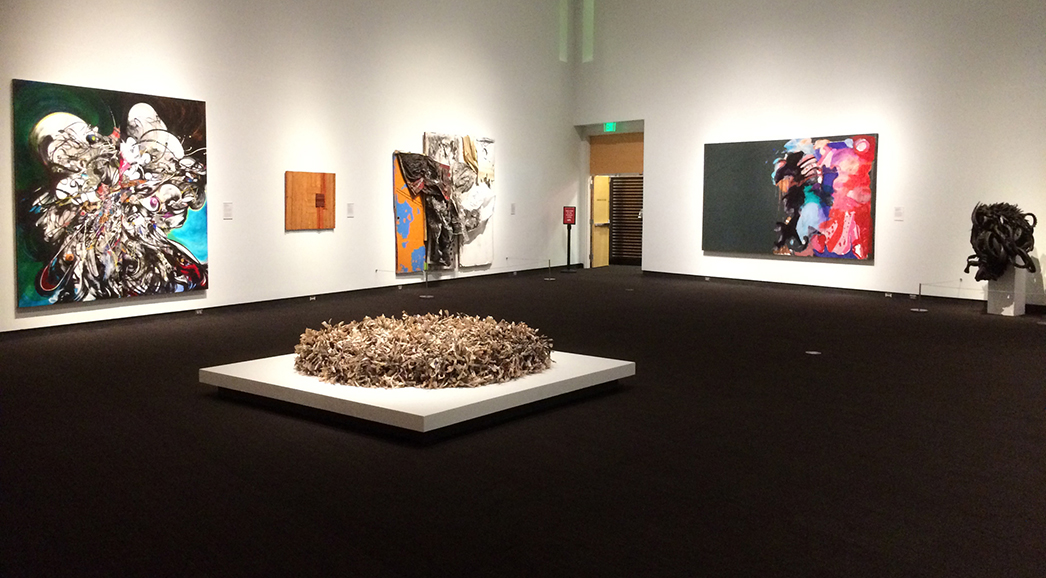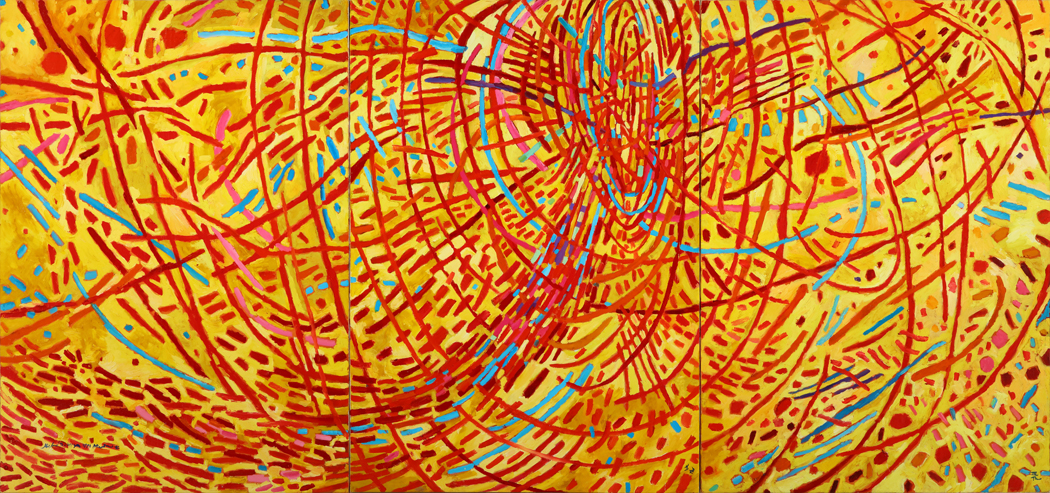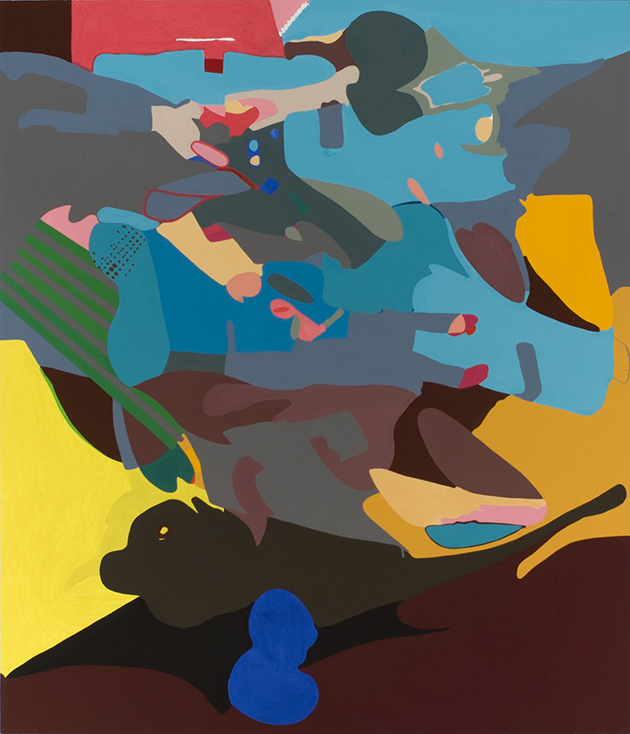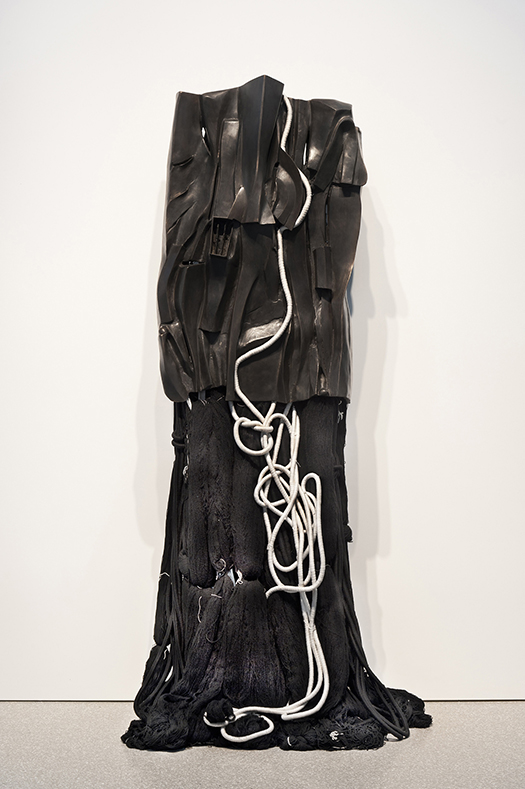
Magnetic Fields: Expanding American Abstraction, 1960s to Today: Museum of Fine Arts, St. Petersburg, Florida
by D. Dominick Lombardi
Magnetic Fields: Expanding American Abstraction, 1960s to Today, which celebrates “the contributions of black women in the field of abstract art”, is a wonderful and stunning exhibition that features many powerful examples of Abstract Art. Walking through the exhibition, I am immediately struck by both the diversity and depth of the selections and the overall scale of the exhibition. Having seen the work of Chakaia Booker many times before, I am very happy to see and experience her work again, especially in this context. El Gato (2001), a rubber tire and wood sculpture that is totally textural and profoundly present, simultaneously challenges and captivates the viewer with waves of wild shapes and fluid gestures.
On the opposite end of the exhibition stands another fascinating sculpture by Shinique Smith. Bale Variant No. 0012 (2015) combines a number of fabrics and materials forming a column-like bale of moments and memories. Clustered and tied in the shape of a tall square column, it immediately becomes a monument to diversity, while the recent images of displaced peoples, especially in Syria may make one think of homelessness and flight. When looking at this work I also think of the old cars and station wagons I have seen over the past few decades packed solid with endless belongings that house marginalized families and individuals who have lost their homes. So we have a message in “Bale Variant No. 0012” that can be both a celebration and a warning, depending on where the viewer’s mind and thoughts happen to be.

Mildred Thompson offers Untitled (Wood Picture) (1966), a simple, but elegant work of art that subtly guides the viewer’s attention in and upward as the quietly shifting shapes glide through our awareness. A large painting by Thompson, Magnetic Fields (1991), shows her innate ability to mix very complex thoughts and theories with elusive and intuitive gestures. Nanette Carter’s Cantilevered #14 (2014), which is comprised of collaged bits of oil on Mylar, has a distinctive structure that suggests a battle between a ‘living’ geology and an uninspired architect’s desire to command nature results this work’s feeling of turmoil. On the other hand, the shifting patterns created by the brushed lines, which easily achieved on the slippery Mylar surface, have a sort of Jazzy-Cubist feel.
Abigail Deville’s Harlem Flag (2014) is a miraculous medley of many media including sheetrock, a door and an American flag that speaks volumes about the history of Harlem and New York City in general – a place that has gone through many intolerable times and tragic moments. I can imagine that some will have a tough time getting passed the flag being used in this way, but it does symbolize, in this instance, the degradation and abuses of a people that will forever mark our history and unfortunately reflect our present and future.
Deborah Dancy’s two mixed works on paper from 2015, Winter Into Spring 2 and Winter Into Spring 4 are meant to express the changing seasons from a cold colorless winter to the hopeful hues of spring. My initial reaction and perhaps what I am leaving here with is more of a coming out, a release from the dark shadowy boundaries one might crawl out from under whether they are physical, emotional or mental constraints.
Howardena Pindell’s mixed media on canvas Autobiography: Japan (Shisen-Do, Kyoto) (1982) features multicolored hole-punched paper to create its curious tactile quality, while post cards and exhibition invitations imbedded here and there are actually a way for the artist to replenish her memory loss. Not knowing this at first, I saw the work as very organic, playful even, while the composition and shape suggests the centrifugal forces that result from a spinning motion. I also see a contrast in the surface, which is something like freshly mixed concrete with a course aggregate, with the collage elements sinking in. Perhaps my reaction is not all that far from the artist’s intent, as her memory is literally disappearing.
The title of Brenna Youngblood’s mixed media painting Yardguard (2015) is an obvious reference to the painted chain-link fence that corrals the composition. What ends up happening here is the dabs of paint, probably a water-soluble paint that are sprayed or splashed with water, spread, run and stain the surface. The resulting dreaminess, albeit highly abstracted, reminds me of Odilon Redon, giving this piece its surreal undertones – an unusual composition to be sure, but a very effective one.

The oil on canvas titled Solitude (1963) by Mavis Pusey also has a jazzy aspect. The canvas, which looks more like jute or burlap, probably looks that way because the artist did an umber paint rub, probably thinned with stand oil, into the texture of the coarse canvas. This is important as the red and brownish black that is applied in distinct, razor sharp shapes seem to float above the surface by contrast. Candida Alvarez offers an acrylic on canvas titled black cherry pit (2009) that is quite Popish in its abstraction, with its very fluid and active composition. Overall, there is a distinctive push/pull here, a clashing of worlds – or should I say a coalescing of worlds – dominated by an overall positive atmosphere disrupted with a few curious twists and turns.
Sylvia Snowden’s June 12 (1992) has a soupy, frothy mix of paint swirls and pours that culminate in a fiery mix that almost totally obscures the background. The acrylic, which is heavy and many layers thick, shines under the museum lights adding to its rich surface texture. Jennie C. Jones has three Minimalist type works. The sound absorbing panels used in the assembling of this work to the artist, speaks of: “long unacknowledged contributions of African American musicians and jazz music to the broader American popular culture.” Not knowing this before I read the wall text – I see more of a sense of meditation – the freeing voids experienced and a subtle but sure tactile awareness one might sense when one’s thoughts are clear and a truer reality or presence of mind emerges.
Betty Blayton’s Consume 12 (1969) is an oil painting on paper mounted on canvas that projects veils of thought or consciousness. The circular shape of the canvas, a tondo, gives this work a more dream-like orientation, while the way in which the artist works, applying shards of paper loosely across the surface, then painting over them with additional thin washes, has a most alluring and mysterious narrative.

Barbara Chase-Riboud’s Malcom X #13 (2008) is meant as a monument to a “transformative individual” in Malcom X. In this tall bronze abstraction we see a soul embellished with silk, wool, linen and synthetic rope – a commanding, albeit twisting form that stands firm against all foes. There are many symbols here, some obvious, others obscure, but the overall feel is a figure that is monk-like in its beliefs and steadfast in its convictions. Kianja Strobert’s Charmer (2016) is something like an otherworldly Lee Bontecou from the 1950s or 60s’, while “Racism is Like Rain, Either it’s Raining or it’s Gathering Somewhere”, a mixed media painting by Mary Lovelace O’Neal, has a distinct and ominous storm brewing against a shroud of darkness. Here, the looming giant forms on the right are menacing mangled masses all twisted and in turmoil in mind and body.
Maren Hassinger’s Wrenching News (2008), which is comprised of a number of gathered, rolled or coiled newspaper pages that featured information about the days following post Katrina, sits on a low, round platform. Here, we see the frustration of many across our land who could only watch in horror as the poor and disenfranchised of the New Orleans area were all too slowly rescued in a painful play of reality – a reality most of us will never forget.
Lilian Thomas Burwell’s mysterious Winged Autumn (2007), a wall mounted sculpture or relief that has obvious references to flight or buoyancy offers a sense of hope, while Evangeline “EJ” Montgomery’s two offset lithographs have very fluid all-over compositions that are quite mesmerizing. Alma Woodsey Thomas, who is “a pioneer in abstraction and the elder in this exhibition” has in Orion (1973) a freedom of form and space that reminds me of the earth’s rotation seen when photographing night sky stars in long exposures. By painting the ‘night sky’ red with what looks like stately tree trunks reflected in calm water, Woodsey Thomas brings multiple worlds and dimensions together in one profound work.
Magnetic Fields: Expanding American Abstraction, 1960s to Today, an exhibition that originated at the Kemper Museum of Contemporary Art in Kansas City Missouri, ends August 5th.
http://mfastpete.org/exh/magnetic-fields/
